Great icosahedron
| Great icosahedron | |
|---|---|
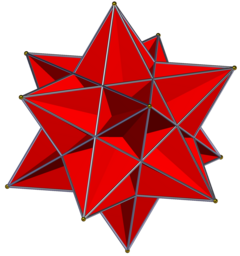
| |
| Type | Kepler–Poinsot polyhedron |
| Stellation core | icosahedron |
| Elements | F = 20, E = 30 V = 12 (χ = 2) |
| Faces by sides | 20{3} |
| Schläfli symbol | {3,5⁄2} |
Face configuration |
V(53)/2 |
| Wythoff symbol | 5⁄2 | 2 3 |
Coxeter diagram |
|
| Symmetry group | Ih, H3, [5,3], (*532) |
| References | U53, C69, W41 |
| Properties | nonconvex deltahedron
|
 (35)/2 (Vertex figure) |
 Great stellated dodecahedron (dual polyhedron) |

In
The great icosahedron can be constructed analogously to the pentagram, its two-dimensional analogue, via the extension of the (n–1)-dimensional simplex faces of the core n-polytope (equilateral triangles for the great icosahedron, and line segments for the pentagram) until the figure regains regular faces. The grand 600-cell can be seen as its four-dimensional analogue using the same process.
Construction
The edge length of a great icosahedron is times that of the original icosahedron.
Images
| Transparent model | Density | Stellation diagram | Net |
|---|---|---|---|
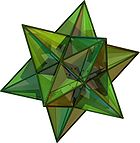 A transparent model of the great icosahedron (See also Animation) |
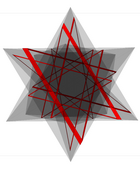 It has a density of 7, as shown in this cross-section. |
Coxeter .
|
 × 12 × 12Net (surface geometry); twelve isosceles pentagrammic pyramids, arranged like the faces of a dodecahedron. Each pyramid folds up like a fan: the dotted lines fold the opposite direction from the solid lines. |
 This polyhedron represents a spherical tiling with a density of 7. (One spherical triangle face is shown above, outlined in blue, filled in yellow) |
Formulas
For a great icosahedron with edge length E,
As a snub
The great icosahedron can be constructed as a uniform
| Tetrahedral | Pyritohedral |
|---|---|
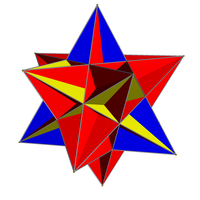
|
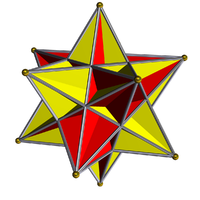
|
Related polyhedra

It shares the same
A truncation operation, repeatedly applied to the great icosahedron, produces a sequence of uniform polyhedra. Truncating edges down to points produces the great icosidodecahedron as a rectified great icosahedron. The process completes as a birectification, reducing the original faces down to points, and producing the great stellated dodecahedron.
The truncated great stellated dodecahedron is a degenerate polyhedron, with 20 triangular faces from the truncated vertices, and 12 (hidden) doubled up pentagonal faces ({10/2}) as truncations of the original pentagram faces, the latter forming two great dodecahedra inscribed within and sharing the edges of the icosahedron.
| Name | Great stellated dodecahedron |
Truncated great stellated dodecahedron
|
Great icosidodecahedron |
Truncated great icosahedron |
Great icosahedron |
|---|---|---|---|---|---|
Coxeter-Dynkin
diagram |
|||||
| Picture | 
|
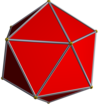
|

|

|

|
References
- ^ Klitzing, Richard. "uniform polyhedra Great icosahedron".
- ISBN 0-521-09859-9.
- MR 0676126. (1st Edn University of Toronto (1938))
- ISBN 0-486-61480-8, 3.6 6.2 Stellating the Platonic solids, pp. 96–104
External links
- Weisstein, Eric W., "Great icosahedron" ("Uniform polyhedron") at MathWorld.
- Uniform polyhedra and duals
| Notable stellations of the icosahedron | |||||||||
| Regular | Uniform duals | Regular compounds
|
Regular star | Others | |||||
| (Convex) icosahedron | Small triambic icosahedron | Medial triambic icosahedron
|
Great triambic icosahedron | Compound of five octahedra | Compound of five tetrahedra | Compound of ten tetrahedra | Great icosahedron | Excavated dodecahedron | Final stellation |
|---|---|---|---|---|---|---|---|---|---|

|

|

|
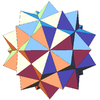
|
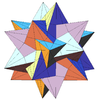
|

|

|
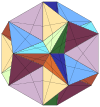
|

| |

|

|

|

|

|

|

|

|

| |
| The stellation process on the icosahedron creates a number of related compounds with icosahedral symmetry .
| |||||||||




